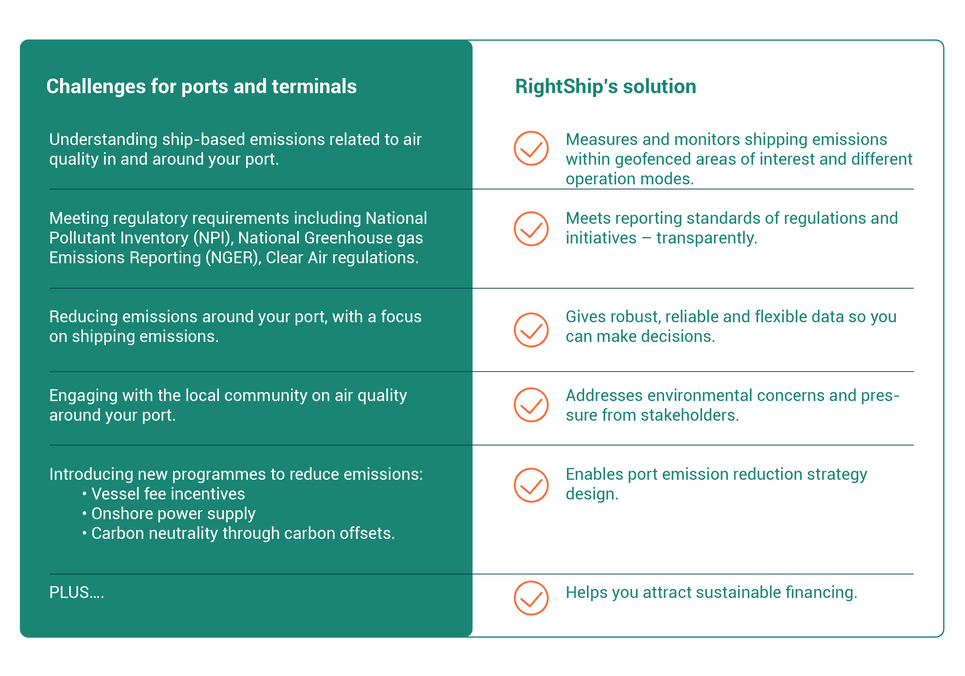RightShip Senior Sustainability Adviser, Tam Pham, discusses why ports and terminals should use our Maritime Emissions Portal

So, Tam, why is the MEP so important to ports and terminals?
A multitude of reasons. Ports are embarking on a journey to digitise processes that measure and reduce emissions. This means that they need to quantify air emissions more accurately from commercial vessels to address industry knowledge gaps and to meet regulatory reporting requirements, such as the National Pollutant Inventory (NPI), National Greenhouse Gas Emissions Reporting (NGER) and Clear Air regulations.
Ports also want to identify opportunities to influence and facilitate a reduction in vessel-based emissions in line with government and industry emissions reduction targets.
It is critical that ports understand their carbon footprint so they can better manage their emissions reduction and carbon offsetting programmes, for instance:
- Port incentives - where discounts are made for more emission-efficient vessels when they call at port.
- Onshore power supply strategy, reducing the use of diesel while in port.
- Achieving carbon neutrality through emission mitigation actions and carbon offsets.
They might also want to engage with their local community on local air quality around the port, and our data supports them to do that in a transparent way.
There’s also increasing pressure on financiers to engage in environmentally and socially responsible lending, so the ports and terminals that have this information to hand will be at an advantage.
How is RightShip helping ports and terminals in their decarbonisation journey?
RightShip can provide ports and terminals with actionable insights, industry perspective and a clear pathway to reduce emissions. Our portal:
- Shows the root causes of air pollution in port by linking vessel operating performance and vessel efficiency insights – strategies can then be developed to reduce these. Combined with RightShip’s other solutions, such as vessel vetting, as well as a port incentive schemes, the port can act to lower vessel emissions.
- Helps ports and terminals meet reporting requirements in line with government and industry emissions reduction targets.
- Aligns with regulatory requirements such as those mentioned above. RightShip’s proprietary emissions methodology leverages AIS tracking technology and validated vessel specific data to generate a detailed emissions inventory.
- Dovetails well with the Smart Ports and Digital Twins initiatives. As a digital solution, the portal can be integrated into Smart Port systems. We will explore these initiatives in more detail in further editions of our thinking.
- Provides meaningful insight, making it easier, quicker and more cost effective to measure shipping and emissions profiles. Combining proprietary data from RightShip’s GHG Rating, including vessel specifications and additional energy saving equipment, with daily automatic vessel positioning data, the portal gives a full view of a port’s emissions profile.
Can ports and terminals be confident that RightShip’s data is robust and reliable?
Absolutely.
As part of its development, the portal was reviewed by independent third-party industry experts from the California Air Resources Board (USA); Ricardo Energy & Environment (UK) and the University of Delaware (USA).
These independent experts validated the principal areas of the portal, including reviewing the data sources and assumptions made, our analytical methods, the consistency of the modelling inputs and the portal’s overall methodology.
Their aim was to review the portal to ensure that stakeholders, including the ports and terminals already using it, have confidence in our methodology and output.
To round up this article, can you summarise why ports and terminals should be using the portal?
RightShip’s Maritime Emissions Portal is the first sustainability data assessment tool of its type and is the initial building block in RightShip’s ESG solution for the ports and terminals sector.
The table below succinctly sums up the challenges ports and terminals face, and how via our new portal, RightShip can help putting ‘ticks in all the boxes’ for our customers.
We will consider each of these challenges in more depth in future articles, to find out more visit Maritime Emissions Portal (rightship.com)
